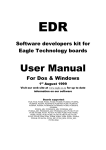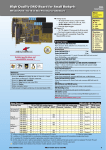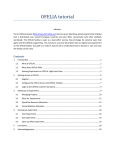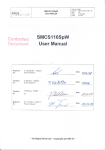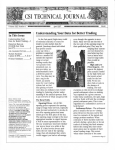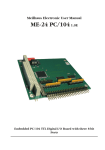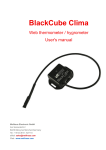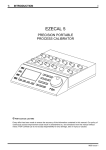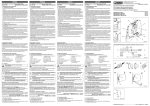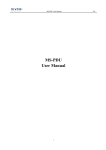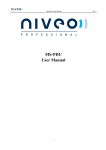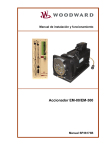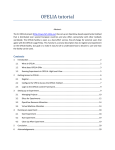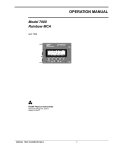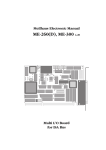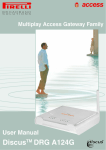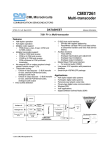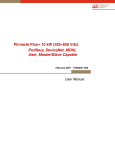Download ME-MultiSig 1.5E - SisNova Engineering GmbH
Transcript
Meilhaus Electronic Manual ME-MultiSig 1.5E (ME-MUX32, ME-DEMUX32, ME-SIG32) Analog Multiplexing/Demultiplexing System with optional Signal Conditioning Modules up to 8192 Channels Imprint Manual ME-MUX32, ME-DEMUX32, ME-SIG32 Revision 1.5E Revised: 22. June 2005 Meilhaus Electronic GmbH Fischerstraße 2 D-82178 Puchheim/Munich Germany http://www.meilhaus.com © Copyright 2005 Meilhaus Electronic GmbH All rights reserved. No part of this publication may be reproduced or distributed in any form whether photocopied, printed, put on microfilm or be stored in any electronic media without the expressed written consent of Meilhaus Electronic GmbH. Important note: The information contained in this manual has been reviewed with great care and is believed to be complete and accurate. Meilhaus Electronic assumes no responsibility for its use, any infringements of patents or other rights of third parties which may result from use of this manual or the product. Meilhaus Electronic assumes no responsibility for any problems or damage which may result from errors or omissions. Specifications and instructions are subject to change without notice. Borland Delphi is a trademark of Borland International Inc. Turbo/Borland C is a trademark of Borland International Inc. Visual C++ and Visual Basic are trademarks of the Microsoft Corporation. VEE Pro and VEE OneLab are trademarks of Agilent Technologies. ME-VEC and ME-FoXX are trademarks of Meilhaus Electronic. Other company names and product names found in the text of this manual are also trademarks of the companies involved. Manual ME-MultiSig Rev. 1.5E Table of Contents 1 Introduction ....................................................................................... 5 1.1 Package Contents ....................................................................... 5 1.2 Features....................................................................................... 6 1.3 1.4 2 Supported PC Boards ............................................................... 8 Model Overview ....................................................................... 9 Hardware ........................................................................................... 10 2.1 General Notes .......................................................................... 10 2.2 Pullup/Pulldown Resistors ...................................................... 10 2.3 2.4 2.5 Model ”Multiplexer” ................................................................ 12 2.3.1 Multiplexer Master Board (ME-MUX32-M) ........................ 12 2.3.2 Multiplexer Slave Board (ME-MUX32-S) ............................ 13 2.3.3 Standard System Expansion ................................................. 14 2.3.4 Full System Expansion .......................................................... 15 2.3.5 Jumper Settings ..................................................................... 17 2.3.6 Gain ..................................................................................... 19 2.3.7 Power Supply ....................................................................... 19 2.3.8 Operating Mode ”Single-MUX”............................................. 20 2.3.8.1 Block Diagram ”Single-MUX” (Master Board)...... 21 2.3.8.2 Block Diagram ”Single-MUX” (Slave Board) ........ 22 2.3.9 Operating Mode ”Multi-MUX” .............................................. 23 2.3.9.1 Block Diagram ”Multi-MUX” (Master Board) ....... 24 2.3.9.2 Block Diagram ”Multi-MUX” (Slave Board).......... 25 Model ”Demultiplexer” ............................................................ 26 2.4.1 Demultiplexer Base Board (ME-DEMUX32) ...................... 26 2.4.2 Operating Mode ”Demux” .................................................... 27 2.4.3 Block Diagram ”Demux” ...................................................... 28 Model ”Signal Conditioning”................................................... 29 2.5.1 Signal Conditioning Base Board (ME-SIG32) ...................... 29 2.5.2 Operating Mode ”Signal Conditioning”................................ 30 2.5.3 Block Diagram ”Signal Conditioning”................................. 31 Meilhaus Electronic Page 3 Table of Contents Rev. 1.5E 2.6 3 Manual ME-MultiSig Plug-On Modules ..................................................................... 32 2.6.1 Calculating the measured values.......................................... 32 2.6.2 Module ME-Proto ................................................................. 34 2.6.3 Module ME-Diff16 ................................................................ 35 2.6.4 Module ME-Current16 ....................................................... 36 2.6.5 Module ME-RTD8 ............................................................ 37 2.6.5.1 2-Wire Connectivity .............................................. 38 2.6.5.2 3-Wire Connectivity .............................................. 38 2.6.5.3 4-Wire Connectivity .............................................. 39 2.6.5.4 Calculating the Temperature ................................ 40 2.6.6 Modul ME-TE8 ................................................................... 42 2.6.6.1 Basics of Thermocouples ..................................... 43 2.6.6.2 Linearity ................................................................. 44 2.6.6.3 Limiting Deviation ................................................ 45 2.6.6.4 Calculating the Temperature ................................ 46 Programming..................................................................................... 49 3.1 Control Signals Overview ..................................................... 50 3.2 Gain Setting ............................................................................. 51 3.3 3.4 Base Board Identification ..................................................... 52 General Reset .......................................................................... 53 3.5 Multiplexing ........................................................................... 54 3.5.1 Operating Mode ”Single-Mux” .................................... 54 3.5.2 Operating Mode ”Multi-Mux” ...................................... 56 Demultiplexing ........................................................................ 58 Signal Conditioning ................................................................ 59 3.6 3.7 Appendix.................................................................................................. 61 A B C D E Specifications............................................................................ 61 Pinouts ...................................................................................... 66 B1 78-pin D-Sub Male Connector ST9........................................ 66 B2 78-pin D-Sub Male Connector ST10...................................... 67 B3 78-pin D-Sub Female Connector ST11.................................. 68 Technical Questions ................................................................. 69 C1 Hotline .................................................................................... 69 C2 Service address ....................................................................... 69 Bibliography ............................................................................. 70 Index ......................................................................................... 71 Table of Contents Page 4 Meilhaus Electronic Manual ME-MultiSig 1 Rev. 1.5E Introduction Valued customer, Thank you for purchasing an innovative high technology product that left our premises in a fully functional and new condition. Please take the time to examine the contents of the package for any loss or damage that may have occurred during shipping. If there are any parts missing or if an item is damaged, please contact Meilhaus Electronic immediately. 1.1 Package Contents We take great care to make sure that the package is complete in every way. We do ask that you take the time to examine the contents of the box. Your box should consist of: • Base board(s) depending on model and level of expansion: - Analog multiplexer board(s) as master (ME-MUX32-M) and optional slave(s) (ME-MUX32-S), - or demultiplexer board (ME-DEMUX32), - or signal conditioning board (ME-SIG32). • Two plug-on bridge modules per base board for operation without signal conditioning modules (except ME-SIG32). • One 40-pin flat ribbon cable per slave board (for master-toslave and/or slave-to-slave connection); 5 jumpers. • Optional: Plug-On modules for signal conditioning. • Screw terminal connectors for analog inputs and power supply. • ME-Power-CD with user manual in PDF format for Acrobat Reader (optional printed manual). • 78-pin D-sub connector for ST11 (not for ME-MUX32-S). Meilhaus Electronic Page 5 Introduction Rev. 1.5E 1.2 Manual ME-MultiSig Features Diagram 1: Analog multiplexing system The analog multiplexing and demultiplexing system expands your multifunctional PC I/O DAQ board, converting it into a versatile multi-channel DAQ system. The following models resp. expansion levels are available: • Analog multiplexing up to 256 resp. 8192 channels with or without signalconditioning (also timer controlled*). • Analog demultiplexing up to 32 channels. • Pure signal conditioning (also timer controlled*). The system consists of at least one master base board with 32 channels. You can expand the system on max. 256 channels, using up to 7 slave base boards. The multiplexer is controlled by the multi I/O PC board‘s digital I/O lines. Each base board has two groups of 16 measurement channels. Each channel group has variable gain, which can be configured via software for the gain factors 1, 10 and 100. The analog input channels can either be multiplexed into one A/D channel (”Single-MUX” mode) or can be multiplexed per group of 16 channels into the A/D channels 0…15 (”Multi-MUX” operation). *in connection with matching multi-I/O boards. Ask our sales department! Introduction Page 6 Meilhaus Electronic Manual ME-MultiSig Rev. 1.5E Additional digital I/O boards and special cables are required for full system expansion, where up to 8192 channels can be multiplexed. For example you are using a digital I/O board with 64 outputs (e. g. ME-1000) for every set of 1024 channels an additional plug-in board is required. Plug-On modules for signal conditioning can be added at any time. At the moment modules for differential acquisition of voltage or current, modules for resistance temperature detectors (RTDs) and a prototyping/breadboard module are available. The base board ME-SIG32 is especially designed for pure signal conditioning on up to 16 or 32 channels (depending on the channel number of the multi I/O board). This model does not have multiplexing or programmable gain. The ME-SIG32 can also be used for data acquisition under timer control*. The same plugon modules are used as for the ME-MUX boards (at least one plug-on module is required for operation. Plug-On modules are not included with the base board). The model ME-DEMUX32 is designed to demultiplex one D/A channel into max. 32 output channels (you can build and add your own signal conditioning plug-on modules based on the prototyping module). Each base board version (except the ME-SIG32) has its own power section with electrical isolation, which has to be externally supplied with 24 V DC. The system can be mounted to DIN-rails. *in connection with matching multi-I/O boards. Ask our sales department! Meilhaus Electronic Page 7 Introduction Rev. 1.5E 1.3 Manual ME-MultiSig Supported PC Boards The following table shows the A/D, D/A and multi I/O boards supported by the analog (de-)multiplexing system (Note: depending on board type and channel number not all base boards are supported): Board type ST9/10 Remark ME-2000 ST9 16 A/D channels, no demultiplexing ME-2600/3000 ST9 16 A/D channels, demultiplexing supported ME-4610 ST10 16 A/D channels, no demultiplexing ME-4650 ST10 16 A/D channels, no demultiplexing ME-4660(i)* ST10 16 A/D channels, demultiplexing supported; notice the note for opto-isolated versions*! ME-4670(i)* ST10 32 A/D channels, demultiplexing supported; notice the note for opto-isolated versions*! ME-4680(i/is)* ST10 32 A/D channels, demultiplexing supported, multiplexing controlled by timer; notice the note for opto-isolated versions*! * This note concerns the use of opto-isolated versions of the ME-4600 series („i“-versions) in combination with the base boards ME-MUX32-M and ME-MUX32-S. Because of the opto-isolation port B is fixed as an input port. This results in the following limitations: • the gain factor is preset to V=1 (V=10, V=100 not adjustable) • the reset bit can not be used • the address LED can not be controlled When using a „i“ version you can avoid these limitations in combination with an adapter board of type ME-AA4-3i. Table 1: Supported ME boards Supported boards from other suppliers: Board type ST9/10 Remark Eagle PC30F/G ST9 16 A/D channels, no demultiplexing (special cable required) Adlink PCI-9111/9112 ST9 16 A/D channels, demultiplexing possible; (set of adaptors and 2nd slot required) Measurement Computing ST9 16 A/D channels, no demultiplexing; (set of adaptors and 2nd slot required) ST9 16 A/D channels, demultiplexing possible; (set of adaptors and 2nd slot required) CIO-DAS-08 Measurement Computing CIO-DAS-1602/16 Table 2: Supported boards from other suppliers Introduction Page 8 Meilhaus Electronic Manual ME-MultiSig Rev. 1.5E Board type ST9/10 Remark National Instruments PCI-6025E ST9 16 A/D channels, demultiplexing possible; (special cable required) UEI PD2-MF-xxx ST9 16 A/D channels, demultiplexing possible; (set of adaptors and 2nd slot required) Table 2: Supported boards from other suppliers 1.4 Model Overview Model Description ME-MUX32-M Multiplexer base board (master) with 32 inputs (with programmable gain) ME-MUX32-S Multiplexer base board (slave) with 32 inputs (with programmable gain) ME-DEMUX32 Demultiplexer base board with 32 outputs (without gain) ME-SIG32 Base board for signal conditioning on up to 32 inputs without multiplexing and gain ME-DIFF16 Signal conditioning module with 16 differential voltage inputs; models available with the input ranges 10V, 20V, 50V (Ri = 3,75MΩ) or 50V (Ri = 50MΩ) ME-Current16 Signal conditioning module with 16 current inputs (0..20mA) ME-RTD8 Signal conditioning module for 8 RTDs with 2-, 3- or 4-wire connectivity; versions for: Pt100, Pt500 or Pt1000 ME-TE8 Signal conditioning module for 8 thermocouples of type J, K, T, E, R, S, B, N ME-Proto Prototyping/breadboard module for custom specific signal conditioning Table 3: Hardware overview Meilhaus Electronic Page 9 Introduction Rev. 1.5E Manual ME-MultiSig 2 Hardware 2.1 General Notes ! Attention: Make sure that no contact with voltage carrying parts can happen by the wiring of the board. The external connections to the board should only be made or removed in a powered down state. Make sure to follow the guide lines for electrostatic sensitive devices. If you do not use any signal conditioning modules, you have to plug on one bridge module per group between ST5 and 6 (group A) or ST7 and 8 (group B). Inputs of the base boards and plug-on modules that are not used should always be connected to signal GND. 2.2 Pullup/Pulldown Resistors After power-up the digital ports of most of the boards are configured as input ports i. e. tristate. To force the digital lines 0…11 into a defined state they are equipped with plugable pulldown (default) resp. pullup resistors (see also chap. 2.2 on page 10). This will set all base boards into their basic status (see chap. 3.4). As a rule the digital ports are configured as inputs after powerup, i. e. the pins are tristate. However to get a defined state after power-up pullup resp. pulldown resistors are provided for the base boards ME-MUX32-M and ME-DEMUX32 (not necessary for ME-MUX32-S and ME-SIG32). They are realized as resistor arrays (RN1, RN2) with sockets. For a pulldown configuration the common pin of the array (marked with a dot as a rule) has to be plugged into the socket pin marked with a „-“ sign. For pullup configuration the common pin of the array has to be plugged into the socket pin marked with a „+“ sign (see diagram 2). Depending on the combination of PC DAQ board and base board the resistor arrays have to be plugged in the right way. Doing this take notice of the following table: Hardware Page 10 Meilhaus Electronic Manual ME-MultiSig Rev. 1.5E Board Type Base Board ST9/10 RN1 RN2 ME-2000/2600/3000 ME-MUX32-M ST9 Pulldown Pulldown ME-DEMUX32 ST9 Pulldown -- ME-4600 Series (with- ME-MUX32-M out opto-isolation) ME-DEMUX32 ST10 Pulldown Pulldown ST10 Pulldown -- ME-MUX32-M ST10 Pullup Pulldown ME-DEMUX32 ST10 Pullup -- ME-MUX32-M ST10 Pullup Pullup ME-DEMUX32 ST10 Pullup -- ME-4600i Series (with opto-isolation*) ME-4600i Series (with opto-isolation and ME-AA4-3i*) *see note in table 1 on page 8. Table 4: Resistor arrays 1 -5V +15V Positioning of the resistor arrays: RN2 (D11..8) Pullup Pulldown RN1 (D7..0) ST11 ST9 ST10 Diagram 2: Resistor arrays Meilhaus Electronic Page 11 Hardware Hardware ST1 ST3 Page 12 CH0 MUX C Channel group A (16 inputs) ST5 Soldering bridge area CH0..15 ST6 MUX A Signal GND CH15 R57 R58 ST11 DAQ board (ME-4000 series) ST10 (ME-2x00/3000) ST9 CH0 +24V 0V AdressLED ST12 PE ME-MUX32-M -15V +15V Remaining DAQ board signals Channel group B (16 inputs) ST7 Soldering bridge area CH16..31 ST8 MUX B Signal GND CH15 ST2 ST4 Rev. 1.5E Manual ME-MultiSig 2.3 Model ”Multiplexer” 2.3.1 Multiplexer Master Board (ME-MUX32-M) internal bus Diagram 3: Multiplexer master board (ME-MUX32-M) Meilhaus Electronic internal bus Meilhaus Electronic CH0 J1 Page 13 Channel group A (16 inputs) ST5 Soldering bridge area CH0..15 ST6 MUX A Signal GND CH15 R57 R58 -15V +15V ME-MUX32-S Address LED 1 2 4 ADR ST12 CH0 +24V J1 Channel group B (16 inputs) ST7 Soldering bridge area CH16..31 ST8 MUX B ST2 Signal GND CH15 J2 ST4 2.3.2 ST1 ST3 PE Manual ME-MultiSig Rev. 1.5E Multiplexer Slave Board (ME-MUX32-S) internal bus Diagram 4: Multiplexer slave board (ME-MUX32-S) Hardware internal bus Rev. 1.5E 2.3.3 Manual ME-MultiSig Standard System Expansion Standard system expansion means, that one master board (ME-MUX32-M) is directly connected to one of the supported PC DAQ boards (see page 8). Connect your Meilhaus boards using a 1:1 cable (ME AK-D78) to ST9 (ME-2000/2600/3000) resp. ST10 (ME-4600 series*). If you use PC DAQ boards from other manufacturers special cables are required (see also table 2). You can connect up to 7 slave boards (ME-MUX32-S) with a 40-pin flat ribbon cable. Just connect the master board‘s ST4 with the first slave board‘s ST3 etc. Each slave board you add will expand your system with 32 channels. On the whole you can multiplex 256 channel into one single-ended A/D channel (input range: ±10 V) of your DAQ board. The channel number can be selected by a soldering bridge, see chapter 2.3.8 and following. Every base board is divided into two groups (A, B) each with 16 input channel. DAQ board Master A 16 inputs A 16 inputs B 16 inputs Slave 7 B 16 inputs A 16 inputs A 16 inputs Slave 1 B 16 inputs Slave 6 B 16 inputs A 16 inputs A 16 inputs Slave 2 B 16 inputs Slave 5 B 16 inputs A Slave 3 16 inputs A 16 inputs Slave 4 16 inputs B B 16 inputs Diagram 5: ME-MUX standard system expansion with 7 slaves As an option, each group can be ”armed” with a signal conditioning module for differential measurement of voltage or current, for resistance temperature detectors (RTDs) or with a prototyping/breadboard module (detailed description see chapter ”Plug-On Modules ”on page 32). A 1:1 bridge module for each group is included. *see note on page 8! Hardware Page 14 Meilhaus Electronic Manual ME-MultiSig Rev. 1.5E You can select the operation modes ”Single-MUX” or ”MultiMUX” (see chapter 2.3.8 and following). Depending on the operating mode the master board‘s soldering bridge area has to be configured properly (standard setting is ”Single-MUX”). If you are using slave boards, please also read chapter 2.3.5 Jumper Settings. 2.3.4 Full System Expansion Full system expansion means, that up to 8192 analog inputs can be multiplexed into 32 single-ended A/D channels of a DAQ board (256 inputs each into one channel). For control we recommend digital I/O boards of the type ME-1000 providing 64 digital I/Os. For every set of 1024 channels an additional ME-1000/64 is required. For 2048 channels you will need a ME-1001 additionally. For 3072 channels you will need an additional ME-1000/64 and for 4096 channels one more ME-1001 etc. Moreover you will need special cables (see diagram 6). Each MUX chain has one master board and up to 7 slave boards. The structure of a single chain is the same as for standard system expansion in ”Single-MUX” mode. Meilhaus Electronic Page 15 Hardware Rev. 1.5E Manual ME-MultiSig Multiplexer Full System Expansion: DAQ board One special adaptor per ME-MUX chain (ME AS-D78M/BNC) 78-pin D-sub male to BNC 1 2 3 4 5 6 7 8 9 10 11 12 13 14 15 Standard BNC cable for analog signal 0 ME-MUX chain 1 (1x master and 7x slave): 8 x 32 = 256 analog inputs ME-MUX chain 2 (1x master and 7x slave): 8 x 32 = 256 analog inputs ME AB-BNC16 ME-MUX chain 16 = max. 4096 channels Digital I/O board ME-1000+ME-1001 (= ME-1000/128) Digital I/O board ME-1000+ME-1001 (= ME-1000/128) 4 x 12 4 x 12 Digital outputs ME-MUX chain 32 = max. 8192 channels Customer specific special cable for digital control signals 4 x 12 4 x 12 Digital outputs Diagram 6: Multiplexer full system expansion Hardware Page 16 Meilhaus Electronic Manual ME-MultiSig 2.3.5 Rev. 1.5E Jumper Settings An internal bus system connects the master board with up to 7 slave boards, using a 40-wire flat ribbon cable. A unique base address (1…7) has to be selected with the jumper ADR to address the individual slave boards. The jumpers J1 and J2 patch the analog channels of the slave boards to the internal bus. Always set the jumpers of the slave boards as shown in diagram 7 and 8. Master Slave 1 Analog channel S1A S1B S2A S2B S3A S3B S4A S4B S5A S5B S6A S6B S7A S7B No jumper settings required. Base address is always "0" J2 J1 Base address 1 2 4 Slave 2 Slave 3 Analog channel Analog channel S1A S1B S2A S2B S3A S3B S4A S4B S5A S5B S6A S6B S7A S7B S1A S1B S2A S2B S3A S3B S4A S4B S5A S5B S6A S6B S7A S7B J2 J1 Base address 1 2 4 ADR = "1" J2 J1 Base address ADR = "2" 1 2 4 ADR = "3" Diagram 7: Jumper settings (master, slave 1-3) Meilhaus Electronic Page 17 Hardware Rev. 1.5E Manual ME-MultiSig Jumper settings (continued) Slave 4 Slave 5 Analog channel Analog channel S1A S1B S2A S2B S3A S3B S4A S4B S5A S5B S6A S6B S7A S7B S1A S1B S2A S2B S3A S3B S4A S4B S5A S5B S6A S6B S7A S7B J2 J1 Base address 1 2 4 J2 J1 Base address 1 2 4 ADR = "4" Slave 6 Slave 7 Analog channel Analog channel S1A S1B S2A S2B S3A S3B S4A S4B S5A S5B S6A S6B S7A S7B S1A S1B S2A S2B S3A S3B S4A S4B S5A S5B S6A S6B S7A S7B J2 J1 Base address 1 2 4 ADR = "5" J2 J1 Base address ADR = "6" 1 2 4 ADR = "7" Diagram 8: Jumper settings (slave 4-8) Hardware Page 18 Meilhaus Electronic Manual ME-MultiSig 2.3.6 Rev. 1.5E Gain The base boards of type ME-MUX32-M and ME-MUX32-S offer a signal amplifier on the base board, which is independent from the DAQ PC board. The gain (V=1, V=10, V=100) can be programmed per group, using the digital control lines of your DAQ board. After power-up the gain is set to V=1. When setting the gain factor, please note, that the PC DAQ board‘s max. input range must not be exceeded (because of this always use V=1 in combination with signal conditioning modules). For further information on programming the gain factors see chapter. 3.2 on page 51. 2.3.7 Power Supply Each base board has to be connected to a suitable DC power supply (18…36 V, typ. 24 V) via the connector ST12. You can calculate the power consumption of your system, depending on the number of base boards and plug-on modules (see appendix A Specifications). We recommend a star connection of all base boards to safety earth (PE) of your rack cabinet or PC. + +24V – + – + – + – PE ST12 ST12 ST12 Diagram 9: Power supply Meilhaus Electronic Page 19 Hardware Rev. 1.5E 2.3.8 Manual ME-MultiSig Operating Mode ”Single-MUX” The operating mode ”Single-MUX” allows you to multiplex up to 256 channels into one A/D channel of your PC DAQ board. For this mode, you have to set the soldering bridge ”A” on the master board for the one DAQ board channel you would like to use. See also diagram 11 and 12. Master board, Group A (A/D channel 0…15): 0 1 2 3 4 5 6 7 8 9 10 11 12 13 14 15 A Master board, Group B (A/D channel 16…31): 16 17 18 19 20 21 22 23 24 25 26 27 28 29 30 31 Diagram 10: Soldering bridges ”Single-MUX” (Default: Chan. 0) Note: The maximum possible channel number depends on the number of A/D channels your PC DAQ board offers. Take care that there is no soldering bridge set on slave boards! Hardware Page 20 Meilhaus Electronic Manual ME-MultiSig 2.3.8.1 Rev. 1.5E Block Diagram ”Single-MUX” (Master Board) A/D or multi I/O board DAQ board A/D channel (single-ended) (preselected: Channel 0) Master 78-pin D-sub male MUX C (ME-MUX32-M) 16-to-1 A K0 Internal bus K1..15 K16..31 MUX A MUX B 16-to-1 16-to-1 Signal conditioning Signal conditioning plug-on module (optional) plug-on modul (optional) Channel group A CH0 DAQ lines CH15 Channel group B Signal GND CH16 DAQ lines CH31 Signal GND Diagram 11: Block diagram ”Single-MUX” (master board) Meilhaus Electronic Page 21 Hardware Rev. 1.5E 2.3.8.2 Manual ME-MultiSig Block Diagram ”Single-MUX” (Slave Board) Optional: Slave 1..7 (ME-MUX32-S) K16..31 K0..15 Internal bus MUX A MUX B 16-to-1 16-to-1 Signal conditioning Signal conditioning plug-on module (optional) plug-on module (optional) Channel group A CH0 DAQ lines CH15 Channel group B Signal GND CH16 DAQ lines CH31 Signal GND Diagram 12: Block diagram ”Single-MUX” (slave board) Hardware Page 22 Meilhaus Electronic Manual ME-MultiSig 2.3.9 Rev. 1.5E Operating Mode ”Multi-MUX” The operating mode ”Multi-MUX“ allows you to multiplex 16 channels groupwise into the PC DAQ board‘s A/D channels 0..15. For this mode you have to set the soldering bridge ”B” on the master board for the channels 0…15 as shown in diagram 13. This will be set… • Master board, channel group A to PC board A/D channel 0, Master board, channel group B to PC board A/D channel 1, • Slave board 1, channel group A to PC board A/D channel 2, Slave board 1, channel group B to PC board A/D channel 3, … etc. (see also diagram 14 and 15) Group A, master board (slave boards: no soldering bridges!): 0 1 B 2 B 3 B 4 B B 5 B 6 B 7 B 8 B 9 B 10 11 12 13 14 15 B B B B B B Group B, master board (slave boards: no soldering bridges!): 16 17 18 19 20 21 22 23 24 25 26 27 28 29 30 31 Diagram 13: Soldering bridges ”Multi-MUX” Meilhaus Electronic Page 23 Hardware Rev. 1.5E Manual ME-MultiSig 2.3.9.1 Block Diagram ”Multi-MUX” (Master Board) A/D or multi I/O board Each channel group is assigned to an analog input channel (single-ended) of the DAQ board (channel 0..15) Master 78-pin D-sub male (ME-MUX32-M) B Internal bus K0..15 K16..31 MUX A MUX B 16-to-1 16-to-1 Signal conditioning Signal conditioning plug-on module (optional) plug-on module (optional) Channel group A CH0 DAQ lines CH15 Channel group B Signal GND CH16 DAQ lines CH31 Signal GND Diagram 14: Block diagram ”Multi-MUX” (master board) Hardware Page 24 Meilhaus Electronic Manual ME-MultiSig 2.3.9.2 Rev. 1.5E Block Diagram ”Multi-MUX” (Slave Board) Optional: Slave 1..7 (ME-MUX32-S) K16..31 K0..15 Internal bus MUX A MUX B 16-to-1 16-to-1 Signal conditioning Signal conditioning plug-on module (optional) plug-on module (optional) Channel group A CH0 DAQ lines CH15 Channel group B Signal GND CH16 DAQ lines CH31 Signal GND Diagram 15: Block diagram ”Multi-MUX” (slave board) Meilhaus Electronic Page 25 Hardware Hardware Page 26 ST1 CH0 DEMUX C Signal GND CH15 J3 R57 R58 from DAQ board (ME-4000 series) ST10 (ME-2x00/3000) ST9 ST11 ST12 PE CH16 +24V 0V Channel group B (16 outputs) ST7 Soldering bridge area CH16..31 ST8 DEMUX B Signal GND CH31 ST2 ME-DEMUX32 Channel group A (16 outputs) ST5 Soldering bridge area CH0..15 ST6 DEMUX A -15V +15V Remaining DAQ board signals Rev. 1.5E Manual ME-MultiSig 2.4 Model ”Demultiplexer” 2.4.1 Demultiplexer Base Board (ME-DEMUX32) Diagram 16: Demultiplexer base board (ME-DEMUX32) Meilhaus Electronic Manual ME-MultiSig 2.4.2 Rev. 1.5E Operating Mode ”Demux” This operating mode allows you to ”divide”/demultiplex one PC DAQ board D/A channel into max. 32 output channels. The demultiplexing board (ME-DEMUX32) is directly connected to your D/A or multi I/O board (supported boards see page 8). Connect your Meilhaus board using a 1:1 cable (ME AK-D78) to ST9 (ME-2600/3000) resp. ST10 (ME-4600 series). If you use PC DAQ boards from other manufacturers special cables are required (see also table 2). The PC board‘s analog output channel used for demultiplexing always has to be D/A channel 0 (or A). Depending on the board model, connector ST9 or ST10 is used and the soldering bridge J3 has to be set according to the picture below (ME-2600/3000: connection ”D”; ME-4600 series: connection ”E”): D/A channel 0 from ST10 (pin 30) e. g. ME-4600 series D/A channel 0 from ST9 (pin 15) e. g. ME-2600/3000 J3 D E DEMUX Diagram 17: Soldering bridge J3 Some board types (e.g. ME-2600/3000) may have a sense line (e. g. D/A-Sense A) for each D/A channel. This sense line has to be connected to the output of the first D/A channel (e. g. D/AOut A) on the demultiplexer board side. To do so, you can use the D-Sub female connector ST11, for example. Please read the chapter refering to the wiring of the D/A channels in your DAQ board user manual. Custom specific user signal conditioning modules based on the prototyping module can be plugged on instead of the standard bridge module at any time. Configurations with up to 256 outputs are available on request. Please contact our technical sales team at: [email protected]. Meilhaus Electronic Page 27 Hardware Rev. 1.5E 2.4.3 Manual ME-MultiSig Block Diagram ”Demux” D/A or D/A channel 0 multi I/O board 78-pin D-sub maler Demultiplexer (ME-DEMUX32) DEMUX C 1-to-2 CH16..31 CH0..15 DEMUX A 1-to-16 1-to-16 customer specific customer specific plug-on module (optional) plug-on module (optional) Channel group A CH0 DEMUX B Analog output CH15 Channel group B Signal GND CH16 Analog output CH31 Signal GND Diagram 18: Block diagram ”Demux” Hardware Page 28 Meilhaus Electronic Meilhaus Electronic Page 29 ST1 CH0 Signal GND CH15 R57 R58 DAQ board (ME-4000 series) ST10 (ME-2x00/3000) ST9 ST11 Remainings DAQ board signals ST12 CH16 Channel group B (16 inputs) ST7 Soldering bridge area CH16..31 ST8 Signal GND CH31 ST2 ME-SIG32 Channel group A (16 inputs) ST5 Soldering bridge area CH0..15 ST6 PE +24V 0V Manual ME-MultiSig Rev. 1.5E 2.5 Model ”Signal Conditioning” 2.5.1 Signal Conditioning Base Board (ME-SIG32) Diagram 19: Signal conditioning base board (ME-SIG32) Hardware Rev. 1.5E 2.5.2 Manual ME-MultiSig Operating Mode ”Signal Conditioning” For pure signal conditioning on up to 16 or 32 channels (depending on the multi I/O board channel number) the base board ME-SIG32 is used. This board does not have a multiplexing and gain section, i. e. no digital control lines are required. The base board is directly connected to one of the supported A/D or multi I/O boards (see page 8). Connect your Meilhaus board using a 1:1 cable (ME AK-D78) to ST9 (ME-2600/3000) resp. ST10 (ME-4600 series). If you use PC DAQ boards from other manufacturers special cables are required (see also table 2). Depending on the multi I/O board features, data acquisition under timer control may be possible. Signal conditioning plug-on modules are available for differential acquisition of voltage or current, for resistance temperature detectors (RTDs) and for prototyping (a detailed description of the modules can be found in chapter ”Plug-On Modules” on page 32). The plug-on modules are not included with the base board (for 16 channels at least one module is required). Custom specific signal conditioning modules based on the prototyping/breadboard module can also be plugged on at any time. No jumpers or soldering bridges have to be set on the ME-SIG32. Connect all inputs you will not use in your DAQ system to signal GND (i.e. inputs of the base boards as well as inputs of the signal conditioning modules). Hardware Page 30 Meilhaus Electronic Manual ME-MultiSig 2.5.3 Rev. 1.5E Block Diagram ”Signal Conditioning” The measurement input channels are connected 1:1 to the DAQ board A/D channels (single-ended, channels 0..15 and/or 0..31) via signal conditioning modules A/D or multi I/O board 78-pin D-sub male Base board signal conditioning (ME-SIG32) C C CH16..31 CH0..15 Signal conditioning Signal conditioning plug-on module (CH0..15) plug-on module (CH16..31) optional Channel group A CH0 DAQ lines CH15 Channel group B Signal GND CH16 DAQ lines Signal CH31 GND Diagram 20: Block Diagram ”Signal Conditioning” Meilhaus Electronic Page 31 Hardware Rev. 1.5E 2.6 Manual ME-MultiSig Plug-On Modules All base boards, except the ME-SIG32, are supplied with bridge modules (i.e. no signal conditioning function). As an option up to 2 plug-on modules for signal conditioning can be added per base board of type ME-MUX32-M, ME-MUX32-S and ME-SIG32. Using two different plug-on modules on one base board is also possible. The power supply (+24V) is provided by the base board. Supply conditioning is done directly on the module. Important note: If plug-on modules are used, a gain setting of V=1 should be used on the base board to avoid damage of your DAQ board. 2.6.1 Calculating the measured values The output voltage range UN of all modules towards the board is standardized to ±10V. Adapt the input voltage range of your DAQ board (as a rule ±10V). • ME-Diff16: The voltage UM calculates as follows (see diagram 21 and 23): U FS [ V ] U M = ---------------------- ⋅ U N [ V ] 10V UFS should be the voltage difference (U+) - (U–) at full-scale depending on the chosen module type (10V, 20V or 50V). • ME-Current16: The current IM calculates as follows (see diagram 21 and 24): 20mA I M = --------------- ⋅ U N [ V ] 10V IFS should be the current difference (I+) - (I–) at full-scale in the range 0…20mA. Hardware Page 32 Meilhaus Electronic Manual ME-MultiSig -10V Rev. 1.5E UM [V] IM [mA] +UFS +IFS = +20mA 0V 0V +10V UN [V] -UFS -10V 0mA 0V +10V UN [V] -IFS = -20mA Diagram 21: Characteristic curves ME-Diff16 (left), ME-Current16 (right) • ME-RTD8: For calculating the temperature values please note chapter 2.6.5 from page 37 on. • ME-TE8: For calculating the temperature values please note chapter 2.6.5 from page 37 on. Meilhaus Electronic Page 33 Hardware Rev. 1.5E 2.6.2 Manual ME-MultiSig Module ME-Proto Prototyping/breadboard module with an area of soldering holes. Use this module to create your own signal conditioning circuitry. Can be used on all base boards. Power supply comes from the base board. Signal GND 24V O1…16 0V ME-Proto 0V 24V Signal GND I1…16 Diagram 22: ME-Proto Hardware Page 34 Meilhaus Electronic Manual ME-MultiSig 2.6.3 Rev. 1.5E Module ME-Diff16 Plug-On module with 16 differential input channels. Depending on the model (see coding on the module backside), the module may have an input range of 10 V, 20 V or 50 V. The absolute value of the voltage difference between the two inputs (U+) and (U–) may not exceed the value of the specified input range. The 50 V input models are available with an input resistance of Ri= 3,75MΩ or Ri=50MΩ . Signal GND 24V 0V +15V -15V -15V +15V ME-Diff16 ST11 U+ STM1 ST9 (ME-2x00/3000) U– 0 1 2 … ST10 … 15 ST1 (ME-4000 series) 0… Signal GND (n.c.) UM Diagram 23: ME-Diff16 The output of the module is always a bipolar voltage value UN in the range of ±10V (see curve in diagram 21). Signal GND is not connected. The lines (U+) and (U–) of each measurement channel are connected to the corresponding clamps on the terminals ST1 and STM1 (see diagram 23). Input channels you will not use should be „short-circuited“. Meilhaus Electronic Page 35 Hardware Rev. 1.5E 2.6.4 Manual ME-MultiSig Module ME-Current16 Plug-On module for measurement of current on 16 differential channels. The input range is 0…20 mA. The absolute value of the current difference between the two inputs (I+) and (I–) may not exceed the range of 0…20 mA. Signal GND 24V 0V +15V -15V -15V +15V ME-Current16 ST11 I+ STM1 ST9 (ME-2x00/3000) I– 0 1 2… ST10 … 15 ST1 (ME-4000 series) 0… Signal GND (n.c.) IM Diagram 24: ME-Current16 The output of the module is always a bipolar voltage value UN in the range of ±10V (see curve in diagram 21). Signal GND is not connected. Connecting signal GND is not required. The lines of each measurement channel are connected to the corresponding clamps on the terminals ST1 and STM1 (see diagram 24). Input channels you will not use have to be „short-circuited“. Hardware Page 36 Meilhaus Electronic Manual ME-MultiSig 2.6.5 Rev. 1.5E Module ME-RTD8 Plug-On module for temperature measurement with platinum resistors (PTC) according to DIN EN 60751. Depending on the model (see coding on the module backside), up to 8 sensors Pt100 (0,4 Ω/°K), Pt500 (2,0 Ω/°K) or Pt1000 (4,0 Ω/°K) can be connected. The temperature range is -200…+850°C. The measurement method is differential, with 2-, 3- or 4-wire connectivity. This helps to transmit the signal as clean as possible to your PC. Signal GND 24V 0V +15V -15V -15V +15V ME-RTD8 ST11 U– U+ STM1 GND IOut ST9 (ME-2x00/3000) 0 1 2 3 4 5 6 ST10 7 ST1 (ME-4000 series) Signal GND (n.c.) IM see chapter "Calculation of Temperature" Diagram 25: ME-RTD8 The output of the module is always a bipolar voltage value UN in the range of ±10V (see curve in diagram 21). Signal GND is not connected. The wires of the temperatur sensors are connected to the corresponding clamps on the terminals ST1 and STM1 (sensor connectivity see page 38 and following). The channels 0…7 of each group will be used. Unused input channels (U+) and (U–) on STM1 should be „shortcircuited“; do not connect IOut and GND! Meilhaus Electronic Page 37 Hardware Rev. 1.5E 2.6.5.1 Manual ME-MultiSig 2-Wire Connectivity The sensor is connected to the module ME-RTD8 using 2 wires (see diagram 26). Like every electric conductor these wires have a resistance, which is in series with the temperature sensor. This means, that the resistance values are added, which will be misinterpreted as a higher temperature. A compensation of this error requires a lot of sophisticated adjustment. To describe the adjustment methods would go beyond the scope of this manual. [2] IOut IM U+ 2-wire connectivity UM U– GND Diagram 26: 2-wire connectivity 2.6.5.2 3-Wire Connectivity 3-wire connectivity (see diagram 27) is used to minimize the influences of the wires‘ resistance and its relation to temperature. An additional third wire leads to a sensor contact. This creates two measurement circuits. One of them is used as a reference (UR). Using 3-wire connectivity compensates the wires‘ resistance as well as its relation to temperature. A further line compensation is not required. [2] IM IOut U+ 3-wire connectivity UM UR U– GND Diagram 27: 3-wire connectivity Hardware Page 38 Meilhaus Electronic Manual ME-MultiSig 2.6.5.3 Rev. 1.5E 4-Wire Connectivity 4-wire connectivity is the best way to connect RTDs to the ME-RTD8 module. Measurement data is neither affected by the line resistance nor by its changes through temperature. Further line compensation is not required. The wires supply the temperature sensor with the measurement current IM. The voltage at the sensor is measured at +U and -U. [2] IM IOut U+ 4-wire connectivity UM U– GND Diagram 28: 4-wire connectivity Meilhaus Electronic Page 39 Hardware Rev. 1.5E 2.6.5.4 Manual ME-MultiSig Calculating the Temperature Note: If you are using base boards of type ME-MUX32-M/S (operation mode „Single-Mux“) in combination with a board of the ME-4600 series we recommend the function me4000MultiSigAIDigitToSize for simple calculation of the temperature. Resistance temperature detectors (RTDs) change their resistance depending on the temperature. For the acquisition of temperatures the voltage drop created by a constant measurement current is measured. A small measurement current should be used to prevent the sensor from getting hot. The ME-RTD8 module‘s typical constant measurement current IM = 500 µA. We recommend to measure the actual constant current of each channel with a high accuracy ampere meter (accuracy better than 1 µA) at the beginning (see diagram 25: example for channel 0) because of unavoidable component tolerances. Note down the measurement value of each channel and use it to calculate the resistance of the temperature sensor: UM R M = -------------IM ⋅ V [formula 1] RM: Calculated resistance of the temperature sensor. UM: Voltage measured between U+ and U–. IM: real constant measuring current (must be measured by the user between IOut and GND - see above). V: Gain factor depending on module type: Pt100: V=40 Pt500: V=8 Pt1000: V=4. R0 is the nominal value of the resistance at 0°C. The mean temperature coefficient (α) between 0°C and 100°C represents the average change of resistance referred to the nominal value at 0°C. Sensor type Temperature coefficient α Nominal value R0 Pt100 0.4Ω/K 100,000Ω Pt500 2,0Ω/K 500,000Ω Pt1000 4,0Ω/K 1000,000Ω Table 5: Sensor characteristics Hardware Page 40 Meilhaus Electronic Manual ME-MultiSig Rev. 1.5E For a Pt100 the nominal value is R0 = 100,000 Ω. It generates a voltage drop of 50 mV, which is measured by the ME-RTD8 module with very high accuracy. [1] For the calculation a difference has to be made between the -200…0°C and the 0…+850°C range. For the range -200…0°C a third degree polynomial is used: R(t) = R0(1 + A x t + B x t2 +C x (t - 100°C) x t3) [formula 2] For the range 0…850°C a second degree polynomial is used: R(t) = R0(1 + A x t + B x t2) [formula 3] …with the coefficients: A = 3,9083 x 10-3 °C-1 B = -5,775 x 10-7 °C-2 C = -4,183 x 10-12 °C-4 The following formula describes the relation of the electric resistance and the temperature for temperatures greater than 0°C: 2 –R0 × A + ( R0 × A ) – 4 × R0 × B × ( R0 – RM ) t = ----------------------------------------------------------------------------------------------------------------------2 × R0 × B [formula 4] RM: Calculated resistance in Ω (from formula 1) t: Temperature in °C R0, A, B: Parameters according to DIN EN 60751 ITS 90 (see above) Meilhaus Electronic Page 41 Hardware Rev. 1.5E 2.6.6 Manual ME-MultiSig Modul ME-TE8 Plug-On module for temperature measurement with thermocouples of type J, T, K, E, N, S, R, B according to DIN EN 60584. The sensor type used can be set by the jumpers JPx1…3 for each channel separately (see diagram 29). For reference junction compensation a sensor is placed near connector STM1. The measurement is always in differential mode with 2-wire connectivity. Signal GND 24V 0V TE Type: ME-TE8 Jumper… JP1 JP2 JP3 JP4 JP5 JP6 JP7 JP8 123123123123123123123123 Jumper set Type B, R, S, T: JPx1 Type K, N: JPx2 (default) Type E, J: JPx3 x = jumper number (1…8) = channel number + 1 ST11 +8V –8V U– U+ STM1 TR 0 ST9 (ME-2x00/3000) 1 2 3 4 5 6 7 ST10 (ME-4000 series) ST1 Signal GND T0 Diagram 29: ME-TE8 The wires of the thermocouples are applied to the clamps on terminal STM1. The positive lines of each thermocouple will be connected to the clamps „U+“ and the negative lines to the clamps „U–“ (ST1 remains not connected). Unused input channels (U+) and (U–) on STM1 should be „short-circuited“. On demand the shield can be connected to Signal GND. Hardware Page 42 Meilhaus Electronic Manual ME-MultiSig Rev. 1.5E The module uses the „Mux“ channels 0…7 for the thermocouples and „Mux“ channel 8 for measuring the reference temperature TR (at the terminal). For calculation of the temperature see chapter 2.6.6.4 on page 46. 2.6.6.1 Basics of Thermocouples With thermocouples the electron flow in an electric conductor is used when it is within a temperature gradient. Now the voltage difference is measured, which depends of the temperature gap and the properties of the conductor material in size and direction. Between the both conductor edges a voltage potential will be extended which results from the temperature gradient along the complete length of the conductor [3]. A disturbing effect occurs when connecting the wire edges to the signal conditioning circuitry (e. g.: ME-TE8). First the thermocouple can only measure the temperature gap (∆T=T0-TR) between measuring junction and reference junction (terminal). Second the standardization (DIN EN 60584) refers to a reference temperature of 0°C. Because of the real reference temperature is different of it (as a rule) it must be compensated (so called reference junction compensation). U+ T0 TR V UM U– Diagram 30: Reference junction compensation If the reference temperature TR (at the terminal) is known, you can calculate the temperature T0 at the measuring junction directly by the thermo-electric voltage measured. The thermo-electric voltage generated by the reference temperature must be added to the measured voltage and equals the thermo-electric voltage refering to 0°C. Meilhaus Electronic Page 43 Hardware Rev. 1.5E Manual ME-MultiSig Example: The temperature of the measuring junction should be 200°C, the temperature at the terminal 20°C (reference temperature) and the measured thermo-electric voltage 9mV. This corresponds with a temperature difference of 180°C. Because of the temperature is referenced to 0°C as a rule the value must be corrected by 20°C up [3]. It is valid: U0 = UM(180°C) (Thermo-electric voltage refering to 0°C) (measured voltage) + UR(20°C) (Thermo-electric voltage of reference junction temperature) Note: The voltage caused by the thermo-electric effect is very low and is only a few microvolts per Kelvin. Generally thermocouples will not be used to measure temperatures in the range ot -30…+50°C because of the difference to the reference temperature is to small in order to get an reliable measurement signal [3]. 2.6.6.2 Linearity The voltage generated by a thermocouple is not linear refering to the temperature. Because of that the user must linearize the values by software. In practice electromotive series (linearization tables) are used, which were calculated based on second to fourth order polynomials and are standardized in DIN EN 605841. They are all refering to a reference temperature of 0°C. As a rule the real reference temperature is different from it. Therefore the measured thermo-electric voltage must be corrected [3]. Example: Thermocouple type „J“ (Fe-CuNi), measured thermoelectric voltage UM=15,308mV, reference temperature TR=20°C. • Version A (correct): Reference temperature of 20°C equals: UR = 1,019 mV U0 = UM + UR = 15,308mV + 1,019 mV = 16,327mV equals a temperature at the measuring junction of 300°C. • Version B (wrong): Reference temperature of 15,308mV equals: ∆T = 282°C T0 = ∆T + TR = 282°C + 20°C = 302°C ⇒ 300°C ≠ 302°C Hardware Page 44 Meilhaus Electronic Manual ME-MultiSig Rev. 1.5E Because of the non-linearity of the voltage it would be wrong first to determine the temperature which corresponds to the measured thermo-electric voltage and then to subtract the reference temperature. From the thermo-electric voltage the voltage corresponding with the reference junction must be subtracted first [3]. 2.6.6.3 Limiting Deviation For thermocouples according to DIN EN 60584 three tolerance classes have been specified. They are valid for thermocouple wires with a diameter of 0,25 to 3 mm and concern delivery state. The classes cannot consider aging effects, because it greatly depends on the environmental conditions. According to the tolerance class the following tolerance deviations are valid (for each the greater value is valid) [3]: TC Type Class J (Fe-CuNi) CLass 1 CLass 2 CLass 3 -40…+750°C ±0,004 · t -40…+750°C ±0,0075 · t –– or ±1,5°C or ±2,5°C –– T (Cu-CuNi) CLass 1 CLass 2 CLass 3 0…+350°C ±0,004 · t -40…+350°C ±0,0075 · t -200…+40°C ±0,015 · t or ±0,5°C or ±1,0°C or ±1,0°C K (NiCr-Ni) und N (NiCrSi-NiSi) CLass 1 CLass 2 CLass 3 -40…+1000°C ±0,004 · t -40…+1200°C ±0,0075 · t -200…+40°C ±0,015 · t or ±1,5°C or ±2,5°C or ±2,5°C E (NiCr-CuNi) CLass 1 CLass 2 CLass 3 -40…+900°C ±0,004 · t -40…+900°C ±0,0075 · t -200…+40°C ±0,015 · t or ±1,5°C or ±2,5°C or ±2,5°C S (Pt10Rh-Pt) und R (Pt13Rh-Pt) CLass 1 or ±1,0°C CLass 2 CLass 3 0…+1600°C ±(1+0,003 · (t-1100°C)) 0…+1600°C ±0,0025 · t –– CLass 1 CLass 2 CLass 3 600…+1700°C ±(0,0025 · t) 600…+1700°C ±0,005 · t –– or ±1,5°C or ±4,0°C –– B (Pt30Rh-Pt6Rh) Limiting Deviation or ±1,5°C –– Table 6: Limiting deviation according to SDIN EN 60584 Meilhaus Electronic Page 45 Hardware Rev. 1.5E 2.6.6.4 Manual ME-MultiSig Calculating the Temperature Notes: Electromotive series (linearization tables) can be found in the specialist literature and from manufacturers like JUMO. Under http://literatur.jumo.info you can download the German PDF document „Elektrische Temperaturmessung“ (FAS146) [3] for free. Additional you can download a useful conversion program named „JUMOsens“ under http://download.jumo.info. It also exports electromotive series in CSV or Microsoft Excel format. If you are using base boards of type ME-MUX32-M/S (operation mode „Single-Mux“) in combination with a board of the ME-4600 series we recommend the function me4000MultiSigAIDigitToSize for simple calculation of the temperature. Basically the following order of operation is valid for calculation of the temperature in combination with module ME-TE8: A. Acquisition of the Reference Temperature TR For measuring the reference temperature at the terminal a semiconductor temperature sensor with a linearization factor of 10 mV/°C is used. The accuracy within the operating temperature range of the module (0…70°C) is ±3,5°C. • In combination with ME-MUX32-M/S: Read the voltage value UN from „Mux“ channel 8 of the respective channel group. See page 54. • In combination with ME-SIG32: Read the voltage value UN from A/D channel 9 resp. 24 of your data acquisition board. See page 59. • Calculate the reference temperature TR as follows: UN - – 50 T R = ----------0, 04 [formula 5] TR is valid for all channels of a module. UN bewegt sich im Bereich 2V…4,8V (entspricht 0…70°C). • For later calculation the thermo-electric voltage UR corresponding to the reference temperature must be determined in dependency of the thermocouple type used: Hardware Page 46 Meilhaus Electronic Manual ME-MultiSig Rev. 1.5E Therefore search in the respective electromotive series the temperature value TR and read the corresponding voltage value (depending on table in mV or µV). B. Acquisition of the Thermo-electric Voltage at the Measuring Junction • In combination with ME-MUX32-M/S: Read the voltage value UN from the wanted „Mux“ channel 0…7 of the respective channel group. See page 54. • In combination with ME-SIG32: Read the voltage value UN from A/D channel 0…7 resp. 16…23 of your data acquisition board. See page 59. • Divide UN by the relevant gain factor V (see table): UM = UN/V B, R, S, T K, N E, J V = 270,270270270 V = 140,845070423 V = 107,526881720 C. Standardization to Reference Temperature 0°C • Because of the standardized electromotive series refer to a reference temperature of 0°C the voltage UR (see „A.“) must be added to UM: U0 = UM + UR • Search in the electromotive series of the thermocouple used the voltage value next to U0 (depending on table in mV or µV) and read the associated temperature value in °C. ⇒ Now you have determined the temperature T0 at the thermocouple wanted. Repeat the steps „B“ and „C“ for the rest of the channels. Depending on the tolerance class of your thermocouple the limiting deviations according to DIN EN 60584 named in table 6 are valid. Meilhaus Electronic Page 47 Hardware Rev. 1.5E Hardware Manual ME-MultiSig Page 48 Meilhaus Electronic Manual ME-MultiSig 3 Rev. 1.5E Programming The PC DAQ board‘s digital ports are used to control the (de)multiplexing and the gain settings. Depending on the base board up to 12 digital output lines are necessary (for ME-SIG32 no specific programming is required). In combination with Meilhaus boards of type ME-2000/2600/3000, their digital I/O lines DIO_0…11 of port A control the base boards. Please use the digital-I/O functions from the function library of your DAQ board for writing the control words. When using opto-isolated versions of the ME-4600 series please read the note on page 8. After power-up the digital ports of most of the boards are configured as input ports i. e. in high impedance state. To force the digital lines 0…11 into a defined state they are equipped with plugable pulldown (default) resp. pullup resistors (see also chap. 2.2 on page 10). This will set all base boards into their basic state (see chap. 3.4). Note: If you are using base boards of type ME-MUX32-M/S (operation mode „Single-Mux“) or of type ME-DEMUX32 in combination with a board of the ME-4600 series you can use the „me4000MultiSig“ functions for fast programming and easy calculation of the values. The functions are included with the function library of the ME-4000 driver. Meilhaus Electronic Page 49 Programming Rev. 1.5E Control Signals Overview V=1 V=10 V=100 Reset (low active) Configuration mode 3.1 Manual ME-MultiSig Gain factor* D10 0 0 1 D9 0 1 0 Write (take over on falling edge) Channel group (A=1, B=0)* Base board (0…7) * Different functionality for address LED control (see chapter "Base Board Identification") R V V W x x x x ADR2…0 G Operation mode 11 10 9 1 x 8 x x 7 6 5 4 3 2 1 0 CH_0…15 CH7…0 MUX C „X“ means: Bit not relevant here. MUX A, B Write (no falling edge may occur!) Reset (must be "1") Diagram 31: Control signals Signal CHx ADRx Description ME-MUX32-M, ME-MUX32-S and ME-DEMUX32: Addressing the channels for (de-)multiplexer operation. (depending on model and operation mode: 0…255) ME-MUX32-M and ME-MUX32-S: Addressing the master (0) resp. the slave boards (1…7) for setting the gain factor and switching the address LED. G ME-MUX32-M and ME-MUX32-S: Selection of channel group (A, B) for gain setting. W ME-MUX32-M and ME-MUX32-S: Data take-over on the falling edge of the write signal. Attention: During a running multiplexer operation no falling edge may occur! V ME-MUX32-M and ME-MUX32-S: Select gain factor and for switching the address LED. R ME-MUX32-M and ME-MUX32-S: Reset signal sets all master and slave boards to gain V=1 and switches off the address LED. Table 7: Control signals Programming Page 50 Meilhaus Electronic Manual ME-MultiSig Rev. 1.5E If you want to work with a gain factor of V=1 you can continue with chapter 3.5 Multiplexing. 3.2 Gain Setting The gain factor can be set individually for each channel group of the base bords ME-MUX32-M and ME-MUX32-S. You can use the control bits D10 and D9 to select the gain factors V=1 (default), V=10 or V=100. Take the following 2 steps per channel group: 1. Preparation: release the reset bit, set the gain factor, set the write signal to „1“, address the base board (D3…1 binary coded) and select the channel group. 2. „Take-over“: on the negative edge of the write signal the setting will be taken over. The following example shows, how to control channel group A on the base board with the address 0 (master). The gain factor V=10 will be set: V=1 V=10 V=100 D10 0 0 1 D9 0 1 0 Channel group (A=1, B=0) Base board (0…7) 1. 1 0 1 1 x x x x 0 0 0 1 0B01hex 2. 1 0 1 0 x x x x 0 0 0 1 0A01hex 11 10 9 8 7 6 5 4 3 2 1 0 Diagram 32: Gain factor Continue with measuring with the desired operation mode „Single-Mux“ (see page 54) or „Multi-Mux“ (see page 56). Meilhaus Electronic Page 51 Programming Rev. 1.5E 3.3 Manual ME-MultiSig Base Board Identification For maintenance or identification purposes the address LED of the base boards ME-MUX32-M and ME-MUX32-S can be activated. The control bits D10 and D9 must be set to ”1” for this. Note, that this will leave the gain factor unchanged. Switching on the LED: 1. Preparation: release the reset bit, set the bits D10 and D9 to „1“, set the write signal to „1“, address the base board with address 7 (for example) and set bit D0 to „1“. 2. „Take-over“: on the negative edge of the write signal the LED will be switched on. Set address LED Base board (0…7) 1. 1 1 1 1 x x x x 1 1 1 1 0F0Fhex 2. 1 1 1 0 x x x x 1 1 1 1 0E0Fhex 11 10 9 8 7 6 5 4 3 2 1 0 Diagram 33: Switching on the address LED Switching off the LED: 1. Preparation: release the reset bit, set the bits D10 and D9 to „1“, set the write signal to „1“, address the base board with address 7 (for example) and set bit D0 to „0“. 2. „Take-over“: on the negative edge of the write signal the LED will be switched off. Set address LED Base board (0…7) 1. 1 1 1 1 x x x x 1 1 1 0 0F0Ehex 2. 1 1 1 0 x x x x 1 1 1 0 0E0Ehex 11 10 9 8 7 6 5 4 3 2 1 0 Diagram 34: Switching off the address LED Programming Page 52 Meilhaus Electronic Manual ME-MultiSig 3.4 Rev. 1.5E General Reset Using the reset-bit you can reset all master and slave boards with a single control word (0000hex). Basic state: • Gain of each group is set to V=1. • All address LEDs are switched off. Reset (low active) 0 0 0 0 0 0 0 0 0 0 0 0 11 10 9 8 7 6 5 4 3 2 1 0 Diagram 35: General reset Meilhaus Electronic Page 53 Programming Rev. 1.5E 3.5 Manual ME-MultiSig Multiplexing For multiplexing a master board of type ME-MUX32-M and optional slave boards (ME-MUX32-S) are required. The digital lines D7…0 are used to control the multiplexers (binary coded). MUX A and B are connected in parallel and are controlled with D3…0, MUX C is controlled by D7…4 (only in operating mode ”Single-Mux”). 3.5.1 Operating Mode ”Single-Mux” Basically the input channel (0…255) selected by the digital lines will be routed to one specific A/D channel of the DAQ board. The A/D channel can be defined by the user (see also chap. 2.3.8 on page 20). Useful control words: 0F00…0FFFhex. Reset (must be "1") Write* MUX C CH_0…15 CH7…0 1 x x x 11 10 9 8 MUX A, B 7 6 5 4 3 2 1 0 *During a running multiplexer operation no falling edge may occur! Diagram 36: Multiplexer control for ”Single-MUX” As a rule the multiplexing is done in a program loop. Beginning with the master board‘s channel 0 of group A, all input channels of a multiplexer chain (max. 256 channels) are multiplexed into one A/D channel of the DAQ board. Basically order of operation: Loop: For i=0 to max. „channel number“ - 1 (FFhex) Control word = i + F00hex (Reset and Write must be „1“) Write control word to digital port Aquire one value on A/D channel 0 of the DAQ board (if master is configured for channel 0) increase i in steps of 1 End of loop Programming Page 54 Meilhaus Electronic Manual ME-MultiSig Rev. 1.5E Block Diagram „Single-Mux“ A/D or multi I/O board DAQ board A/D channel (single-ended) (preselected: Channel 0) Master 78-pin D-sub male Optional: Slave 1..7 (ME-MUX32-S) MUX C (ME-MUX32-M) 16-to-1 Internal bus MUX A 16-to-1 16-to-1 MUX B 16-to-1 16-to-1 Signal conditioning Signal conditioning Signal conditioning Signal conditioning plug-on module (optional) plug-on modul (optional) plug-on module (optional) plug-on module (optional) Channel group A CH0 MUX A MUX B DAQ lines CH15 Channel group A Channel group B Signal GND CH16 DAQ lines Signal GND CH31 CH0 DAQ lines Channel group B Signal GND CH15 CH16 DAQ lines CH31 Signal GND Diagram 37: Block diagram „Single-Mux“ Block Diagram „Multi-Mux“ A/D or multi I/O board Each channel group is assigned to an analog input channel (single-ended) of the DAQ board (channel 0..15) Master 78-pin D-sub male Optional: Slave 1..7 (ME-MUX32-S) (ME-MUX32-M) Internal bus MUX A MUX B 16-to-1 16-to-1 MUX B 16-to-1 16-to-1 Signal conditioning Signal conditioning Signal conditioning Signal conditioning plug-on module (optional) plug-on module (optional) plug-on module (optional) plug-on module (optional) Channel group A CH0 MUX A DAQ lines CH15 Channel group B Signal GND CH16 DAQ lines CH31 Channel group A Signal GND CH0 DAQ lines CH15 Channel group B Signal GND CH16 DAQ lines CH31 Signal GND Diagram 38: Block digram „Multi-Mux“ Meilhaus Electronic Page 55 Programming Rev. 1.5E 3.5.2 Manual ME-MultiSig Operating Mode ”Multi-Mux” The assignment of the 16 input channels of a group (max. 16 groups in one multiplexer chain) to the A/D channels of the DAQ board is fixed (see also chap. 2.3.9 on page 23). I. e the inputs of group A on the master board will be acquired by channel 0 of the DAQ board. Depending on the level of expansion this is continued up to group B of slave board 7, whose inputs will be acquired by A/D channel 15. Note that all groups within a multiplexer chain are switching synchron to the channel number Kx selected by the digital I/O lines. Useful control words: 0F00…0F0Fhex. Reset (must be "1") Write* MUX A, B 1 x x x x x x x CH_0…15 CH3…0 11 10 9 8 7 6 5 4 3 2 1 0 *During a running multiplexer operation no falling edge may occur! Diagram 39: Multiplexer setting for ”Multi-MUX” operation As a rule the multiplexing is done in a program loop. Beginning with channel 0 (Kx=0) the 16 input channels are routed in groups to the assigned A/D channel of the DAQ board (see above). The number of necessary A/D channels corresponds with the number of groups in your multiplexer chain (depending on level of expansion up to 16). When using a suitable DAQ board it is also possible to acquire (scan) the channels Kx of each group by timer control. Then the input channels of the multiplexer boards will be switched to the next channel (max. Kx=15) and a new scan operation can be started. (see also block diagram on next page) Programming Page 56 Meilhaus Electronic Manual ME-MultiSig Rev. 1.5E Basically order of operation: Loop: For i=0 to max. „channel number per group“ - 1 (0Fhex) Control word = i + F00hex (Reset and Write must be „1“) Write control word to digital port Aquire A/D channel 0 to max. 15. Can also be done controlled by timer (scan). increase i in steps of 1 End of loop Meilhaus Electronic Page 57 Programming Rev. 1.5E 3.6 Manual ME-MultiSig Demultiplexing This operation mode requires a base board of type ME-DEMUX32. First choose the demultiplexer´s output channel (K0…31) by the digital lines. Useful control words are in the range of: 00…1Fhex. Next output the voltage value wanted by D/A-channel 0 of your D/A resp. multi-I/O board. DEMUX C x x DEMUX A, B x x x x x 11 10 9 8 7 6 5 CH4…0 4 3 2 1 0 Diagram 40: Controlling the demultiplexer The bits D11…5 are not relevant in this operation mode. As a rule demultiplexing is done in a program loop. Beginning with channel 0 of the demultiplexer board, the voltage value to be output will be „demultiplexed“ from the D/A- resp. multi-I/O board to the outputs of the ME-DEMUX32. Basically order of operation: Loop: For i=0 to max. „channel number“ - 1 (1Fhex) Control word = i Write control word to digital port Output voltage value to D/A channel 0 increase i in steps of 1 End of loop (see also block diagram on next page) Programming Page 58 Meilhaus Electronic Manual ME-MultiSig Rev. 1.5E Block Diagram „Demux“ D/A or D/A channel 0 multi I/O board 78-pin D-sub maler Demultiplexer (ME-DEMUX32) DEMUX C 1-to-2 CH16..31 CH0..15 DEMUX A 1-to-16 1-to-16 customer specific customer specific plug-on module (optional) plug-on module (optional) Channel group A CH0 DEMUX B Analog output CH15 Channel group B Signal GND CH16 Analog output CH31 Signal GND Diagram 41: Block diagram „Demux“ 3.7 Signal Conditioning When using the base board ME-SIG32 no digital control lines are required. Programming will be limited to the analog aquisition with your PC DAQ board. The max. sampling rate depends on the plug-on modules used (see specifications on page 61ff). Meilhaus Electronic Page 59 Programming Rev. 1.5E Programming Manual ME-MultiSig Page 60 Meilhaus Electronic Manual ME-MultiSig Rev. 1.5E Appendix A Specifications Base Board ME-MUX32-M (Master) Analog input channels Gain factors Accuracy at V=1 Accuracy at V=10 Accuracy at V=100 Dynamic signals Multiplexer switching time Operating modes Connector - DAQ board Connector - power supply Connector - signals Master-slave connection 32 total in 2 groups (A, B) of 16 channels each V = 1, 10, 100 typ. ±0,15% at FS (±10 V) typ. ±0,2% at FS (±1 V) typ. ±0,5% at FS (±100 mV) V=1: max. 400 kHz at ±10 V V=10: max. 100 kHz at ±1 V V=100: max. 40 kHz at ±100 mV ≤ 300 ns ”Single-MUX”: max. 256 inputs multiplexed into one A/D channel ”Multi-MUX”: the 16 channels of a group multiplexed into separate A/D channels 78-pin D-sub male connector (ST9 or ST10) 3 screw terminals (plugable) for power supply 2 x 18pin terminal (plugable) Internal bus via 40-pin flat ribbon cable Base Board ME-MUX32-S (Slave) Analog input channels 32 total in 2 groups (A, B) of 16 channels each Gain factors V = 1, 10, 100 Accuracy at V=1 typ. ±0,15% at FS (±10 V) Accuracy at V=10 typ. ±0,2% at FS (±1 V) Accuracy at V=100 typ. ±0,5% at FS (±100 mV) Dynamic signals V=1: max. 400 kHz at ±10 V V=10: max. 100 kHz at ±1 V V=100: max. 40 kHz at ±100 mV Multiplexer switching time ≤ 300 ns Connector - power supply 3 screw terminals (plugable) for power supply Connector - signals 2 x 18pin terminal (plugable) Master-slave connection Internal bus via 40-pin flat ribbon cable Meilhaus Electronic Page 61 Specifications Rev. 1.5E Manual ME-MultiSig Base Board ME-DEMUX32 Analog output channels Dynamic signals Current per channel Forward resistance Operating modes Connector - DAQ board Connector - power supply Connector - signals Multiplexer switching time 32 total in 2 groups (A, B) of 16 channels each max. 2 MHz at ±10 V max. 25 mA <100 Ω D/A channel demultiplexed into 32 analog outputs 78-pin D-sub male connector (ST9 or ST10) 3 screw terminals (plugable) for power supply 2 x 18pin terminal (plugable) ≤300 ns Base Board ME-SIG32 Analog input channels Connector - DAQ board Connector - power supply Connector - signals Specifications 16 or 32 depending on PC DAQ board‘s number of A/D channels 78-pin D-sub male connector (ST9 or ST10) 3 screw terminals (plugable) for power supply 2 x 18pin terminal (plugable) Page 62 Meilhaus Electronic Manual ME-MultiSig Rev. 1.5E Plug-On Module ME-Diff16 Measurement channels ME-Diff16-10V ME-Diff16-20V ME-Diff16-50V-3,75MΩ ME-Diff16-50V-50MΩ Connectors 16 differential channels input range: ±10 V input resistance: >200 GΩ accuracy: typ. 0,3% dynamic signals: max. 15 kHz at ±10 V input range: ±20 V input resistance: >20 MΩ accuracy: typ. 0,8% dynamic signals: max. 2,5 kHz at ±10 V input range: ±50 V input resistance: 3,75 MΩ accuracy: typ. 0,8% dynamic signals: max. 2,5 kHz at ±10 V input range: ±50 V input resistance: 50 MΩ accuracy: typ. 3,4% dynamic signals: max. 1 kHz at ±50 V 18pin terminal (STMx) on the module plus 18pin terminal (STx) on the base board Plug-On Module ME-Current16 Measurement channels Input range Input resistance Accuracy Connectors Meilhaus Electronic 16 differential channels 0..20 mA 499 Ω/0,1% typ. 0,15% 18pin terminal (STMx) on the module plus 18pin terminal (STx) on the base board Page 63 Specifications Rev. 1.5E Manual ME-MultiSig Plug-On Module ME-RTD8 Measurement channels Connectivity Gain factor 8 channels for PTC/RTD sensors 2-wire, 3-wire or 4-wire fixed depending on module type: Pt100: V=40 Pt500: V=8 Pt1000: V=4 Sensor type fixed depending on module type: Pt100: R0(0°C) = 100,000Ω (α=0,4Ω/K) Pt500: R0(0°C) = 500,000Ω (α=2,0Ω/K) Pt1000: R0(0°C) = 1000,000Ω (α=4,0Ω/K) Temperature range -200..+850°C Constant measurement current typ. 500 µA Accuracy after determination of actual measurement current: ±1°C Input resistance >200 GΩ Connectors 18pin terminal (STMx) on the module plus 18pin terminal (STx) on the base board Plug-On Module ME-TE8 Measurement channels 8 channels for thermocouples according to DIN EN 60584 Connectivity 2-wire Connectors 18pin terminal (STMx) on the module Sensor types J, T, K, E, N, S, R, B (tpye selectable by jumper for each channel) Gain factors B, R, S, T: V=270,270270270 K, N: V=140,845070423 E, J: V=107,526881720 Gain error typ. ±0,01% Linearization error typ. 3ppm Input offset voltage typ. ±1µV Input bias current typ. 2,5pA Sensor for reference junction compensation: Type Semiconductor sensor (V=4) Linearity factor +10,0mV/°C Offset +500mV Accuracy max. ±3,5°C Specifications Page 64 Meilhaus Electronic Manual ME-MultiSig Rev. 1.5E General Input range Power consumption 18…36 V (typ. 24 V) base board: typ. 60 mA modules: typ. 60 mA Size - base board 250 x 100 mm (L x W) (without card carrier) Size - modules 72 x 87 mm (L x W) Mounting incl. card carrier for DIN rails Height incl. card carrier, without modules and connectors: 67 mm Height incl. card carrier, modules and connectors: ca. 150 mm Operating temperature 0…70°C Storage temperature 0…50°C Humidity 20…55% (non condensing) CE Certification EG guidelines Emission Noise immunity Meilhaus Electronic 89/336/EMC EN 55022 EN 50082-2 Page 65 Specifications Rev. 1.5E B Manual ME-MultiSig Pinouts Connecting multi-I/O DAQ boards, depending on the model: B1 78-pin D-Sub Male Connector ST9 Connector for boards of type ME-2000/2600/3000 and some boards of other manufacturers (see table 2 on page 8). Signal-GND 20 AD_0 AD_1 19 AD_3 18 AD_5 17 AD_7 16 DA_0 15 DA_2 14 AD_2 AD_4 AD_6 Signal-GND DA_1 DA_3 PC_GND 13 PWM_OUT n.c. 12 UP/DOWN_A 11 PC_GND 10 DIO_A1/DIO_1* 9 DIO_A3/DIO_3* 8 DIO_A5/DIO_5* 7 DIO_A7/DIO_7* 6 DIO_A9/DIO_9* 5 DIO_A11/DIO_11* 4 DIO_A13 3 DIO_A15 2 n.c. 1 GATE_A CLK_A DIO_A0/DIO_0* DIO_A2/DIO_2* DIO_A4/DIO_4* DIO_A6/DIO_6* DIO_A8/DIO_8* DIO_A10/DIO_10* DIO_A12 DIO_A14 Signal-GND 59 39 78 58 38 77 57 37 76 56 36 75 55 35 74 54 34 73 53 33 72 52 32 71 51 31 70 50 30 69 49 29 68 48 28 67 47 27 66 46 26 65 45 25 64 44 24 63 43 23 62 42 22 61 41 21 60 40 Signal-GND AD_8 AD_9 AD_10 AD_11 AD_12 AD_13 AD_14 AD_15 Signal-GND DA_Sense_0 DA_Sense_1 DA_Sense_2 DA_Sense_3 EXT_TRIG_DA EXT_IRQ EXT_TRIG_AD GATE_B UP/DOWN_B CLK_B n.c. DIO_B0 DIO_B1 DIO_B2 DIO_B3 DIO_B4 DIO_B5 DIO_B6 DIO_B7 DIO_B8 DIO_B9 DIO_B10 DIO_B11 DIO_B12 DIO_B13 DIO_B14 DIO_B15 n.c. Diagram 42: Pinout 78-pin D-sub male connector ST9 *Index corresponds with the bit number of the MultiSig control lines. Pinouts Page 66 Meilhaus Electronic Manual ME-MultiSig B2 Rev. 1.5E 78-pin D-Sub Male Connector ST10 Connector for boards of the ME-4600 series. Signal-GND 20 AD_1 19 AD_3 18 AD_5 17 AD_7 16 AD_16 15 AD_0 AD_2 AD_4 AD_6 Signal-GND AD_17 AD_18 14 AD_20 13 AD_19 AD_21 AD_22 12 PC_GND 11 DA_1 10 DIO_A1/DIO_1* 9 DIO_A3/DIO_3* 8 DIO_A5/DIO_5* 7 DIO_A7/DIO_7* 6 DIO_B1/DIO_9* 5 DIO_B3/DIO_11* 4 AD_23 DA_0 DIO_A0/DIO_0* DIO_A2/DIO_2* DIO_A4/DIO_4* DIO_A6/DIO_6* DIO_B0/DIO_8* DIO_B2/DIO_10* DIO_B4 DIO_B5 3 DIO_B7 2 n.c. 1 DIO_B6 Signal-GND 59 39 78 58 38 77 57 37 76 56 36 75 55 35 74 54 34 73 53 33 72 52 32 71 51 31 70 50 30 69 49 29 68 48 28 67 47 27 66 46 26 65 45 25 64 44 24 63 43 23 62 42 22 61 41 21 60 40 Signal-GND AD_8 AD_9 AD_10 AD_11 AD_12 AD_13 AD_14 AD_15 Signal-GND AD_24 AD_25 AD_26 AD_27 AD_28 AD_29 AD_30 AD_31 AD_TRIG_A+ AD_TRIG_ADA_2 DA_3 EXT_IRQ AD_TRIG_D DA_TRIG_0 DA_TRIG_1 DA_TRIG_2 DA_TRIG_3 PC_GND (DIO_GND) GATE_0 OUT_0 CLK_0 GATE_1 OUT_1 CLK_1 GATE_2 OUT_2 CLK_2 PC_GND Diagram 43: Pinout 78-pin D-sub male connector ST10 *Index corresponds with the bit number of the MultiSig control lines. Description in brackets is valid in connection with optoisolated boards of the ME-4600 series. Meilhaus Electronic Page 67 Pinouts Rev. 1.5E B3 Manual ME-MultiSig 78-pin D-Sub Female Connector ST11 All lines (except of pin 1) are wired from ST9 resp. ST10 1:1 to the D-Sub female connector ST11. Signal-GND 59 39 78 58 38 77 57 37 76 56 36 75 55 Signal-GND 35 74 54 34 73 53 33 72 52 32 71 51 31 70 50 30 69 49 29 68 48 28 67 47 27 66 46 26 65 45 25 64 44 24 63 43 23 62 42 22 61 41 21 60 40 20 Signal-GND 19 18 17 16 Signal-GND 15 14 13 12 11 10 9 8 7 6 5 4 3 2 Signal-GND 1 n.c. Diagram 44: Pinout 78-pin D-Sub female connector ST11 Pinouts Page 68 Meilhaus Electronic Manual ME-MultiSig Rev. 1.5E C Technical Questions C1 Hotline If you should have any technical questions or problems with the board , please send a fax to our hotline: Fax hotline: eMail: ++ 49 (0) 89/89 01 66 28 [email protected] Please give a full description of the problems and as much information as possible, including operating system information. C2 Service address We hope that your board will never need to be repaired. If this should become necessary please contact us at the following address: Meilhaus Electronic GmbH Service Department Fischerstraße 2 D-82178 Puchheim/Germany If you would like to send us a board for repair, please do not forget to add a full description of the problem. Meilhaus Electronic Page 69 Technical Questions Rev. 1.5E D Manual ME-MultiSig Bibliography (in German language) [1] Texts and formulas in chapter 2.6.5 faithfully translated according to: „JUMO Typenblatt 90.6000“, page 1. [2] D.Weber, „Elektrische Temperaturmessung - Mit Thermoelementen und Widerstandsthermometern“, 9th edition, February 2001 [3] Texts and tables in chapter 2.6.5 faithfully translated according to: Matthias Nau, „Elektrische Temperaturmessung - Mit Thermoelementen und Widerstandsthermometern“, JUMO book number: FAS 146, February 2003, ISBN 3-935742-06-1 [4] TC Meß- und Regeltechnik GmbH, „Handbuch zur Temperaturmessung mit Thermoelementen und Widerstandsthermometern“, 2004 [5] Gerd Scheller, „Messunsicherheit einer Temperaturmesskette mit Beispielrechnungen“, JUMO book number: FAS 625, April 2003, ISBN: 3-935742-12-6 See also: Literature from JUMO: http://literatur.jumo.info Software from JUMO: http://download.jumo.info Bibliography Page 70 Meilhaus Electronic Manual ME-MultiSig E Rev. 1.5E Index B Multiplexing 54 Multi-Mux 56 Single-Mux 54 Reset-Bit 53 Signal Conditioning 59 PTC 37 Pullup/Pulldown Resistors 10 Base board identification 52 Bibliography 70 D Demultiplexer Base Board 26 F Features 6 Full System Expansion 15 R G RTDs 37 2-Wire Connectivity 38 3-Wire Connectivity 38 4-Wire Connectivity 39 Temperature Calculation 40 Gain Setting 51 General Notes 10 H Hardware 10 I S Introduction 5 Service and Support 69 Signal Amplifier 19 Signal Conditioning Base Board 29 Slave Board 13 Specifications 61 Standard System Expansion 14 Supported PC Boards 8 J Jumper Settings 17 M Master Board 12 Multiplexer 12 O Operating Mode De-Mux 27 Multi-Mux 23 Signal Conditioning 30 Single-Mux 20 P Pinouts 66 Plug-On Modules 32 ME-Current16 36 ME-Diff16 35 ME-Proto 34 ME-RTD8 37 ME-TE8 42 Power Supply 19 Programming 49 Demultiplexing 58 Meilhaus Electronic T Technical Questions 69 Thermocouples Basics 43 Limiting Deviation 45 Linearity 44 Temperature Calculation 46 Thermocouple Types 42 Page 71 Index







































































